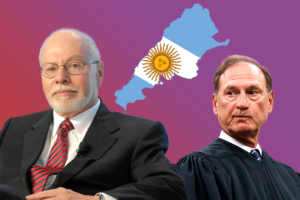Colonization by Bankruptcy: High-Stakes Chess for Argentina
Territories were once captured by military might. Today they are annexed by debt. Destitute nations are driven into international bankruptcy courts that could do with whole countries what bankruptcy courts do with businesses: sell off their assets, including real estate. Sovereign territories could be acquired as the spoils of bankruptcy without a single shot being fired.
By Ellen Brown, Web of DebtThis piece first appeared at Web of Debt.
If Argentina were in a high-stakes chess match, the country’s actions this week would be the equivalent of flipping over all the pieces on the board.
– David Dayen, Fiscal Times, August 22, 2014
Argentina is playing hardball with the vulture funds, which have been trying to force it into an involuntary bankruptcy. The vultures are demanding what amounts to a 600% return on bonds bought for pennies on the dollar, defeating a 2005 settlement in which 92% of creditors agreed to accept a 70% haircut on their bonds. A US court has backed the vulture funds; but last week, Argentina sidestepped its jurisdiction by transferring the trustee for payment from Bank of New York Mellon to its own central bank. That play, if approved by the Argentine Congress, will allow the country to continue making payments under its 2005 settlement, avoiding default on the majority of its bonds.
Argentina is already foreclosed from international capital markets, so it doesn’t have much to lose by thwarting the US court system. Similar bold moves by Ecuador and Iceland have left those countries in substantially better shape than Greece, which went along with the agendas of the international financiers.
The upside for Argentina was captured by President Fernandez in a nationwide speech on August 19th. Struggling to hold back tears, according to Bloomberg, she said:
When it comes to the sovereignty of our country and the conviction that we can no longer be extorted and that we can’t become burdened with debt again, we are emerging as Argentines.
. . . If I signed what they’re trying to make me sign, the bomb wouldn’t explode now but rather there would surely be applause, marvelous headlines in the papers. But we would enter into the infernal cycle of debt which we’ve been subject to for so long.
The Endgame: Patagonia in the Crosshairs
The deeper implications of that infernal debt cycle were explored by Argentine political analyst Adrian Salbuchi in an August 12th article titled “Sovereign Debt for Territory: A New Global Elite Swap Strategy.” Where territories were once captured by military might, he maintains that today they are being annexed by debt. The still-evolving plan is to drive destitute nations into an international bankruptcy court whose decisions would have the force of law throughout the world. The court could then do with whole countries what US bankruptcy courts do with businesses: sell off their assets, including their real estate. Sovereign territories could be acquired as the spoils of bankruptcy without a shot being fired.
Global financiers and interlocking megacorporations are increasingly supplanting governments on the international stage. An international bankruptcy court would be one more institution making that takeover legally binding and enforceable. Governments can say no to the strong-arm tactics of the global bankers’ collection agency, the IMF. An international bankruptcy court would allow creditors to force a nation into bankruptcy, where territories could be involuntarily sold off in the same way that assets of bankrupt corporations are.
For Argentina, says Salbuchi, the likely prize is its very rich Patagonia region, long a favorite settlement target for ex-pats. When Argentina suffered a massive default in 2001, the global press, including Time and The New York Times, went so far as to propose that Patagonia be ceded from the country as a defaulted debt payment mechanism.
The New York Times article followed one published in the Buenos Aires financial newspaper El Cronista Comercial called “Debt for Territory,” which described a proposal by a US consultant to then-president Eduardo Duhalde for swapping public debt for government land. It said:
[T]he idea would be to transform our public debt default into direct equity investment in which creditors can become land owners where they can develop industrial, agricultural and real estate projects. . . . There could be surprising candidates for this idea: during the Alfonsin Administration, the Japanese studied an investment master plan in Argentine land in order to promote emigration. The proposal was also considered in Israel.
Salbuchi notes that ceding Patagonia from Argentina was first suggested in 1896 by Theodor Herzl, founder of the Zionist movement, as a second settlement for that movement.
Another article published in 2002 was one by IMF deputy manager Anne Krueger titled “Should Countries Like Argentina Be Able to Declare Themselves Bankrupt?” It was posted on the IMF website and proposed some “new and creative ideas” on what to do about Argentina. Krueger said, “the lesson is clear: we need better incentives to bring debtors and creditors together before manageable problems turn into full-blown crises,” adding that the IMF believes “this could be done by learning from corporate bankruptcy regimes like Chapter 11 in the US”.
These ideas were developed in greater detail by Ms. Krueger in an IMF essay titled “A New Approach to Debt Restructuring,” and by Harvard professor Richard N. Cooper in a 2002 article titled “Chapter 11 for Countries” published in Foreign Affairs (“mouthpiece of the powerful New York-Based Elite think-tank, Council on Foreign Relations”). Salbuchi writes:
Here, Cooper very matter-of-factly recommends that “only if the debtor nation cannot restore its financial health are its assets liquidated and the proceeds distributed to its creditors – again under the guidance of a (global) court” (!).
In Argentina’s recent tangle with the vulture funds, Ms. Krueger and the mainstream media have come out in apparent defense of Argentina, recommending restraint by the US court. But according to Salbuchi, this does not represent a change in policy. Rather, the concern is that overly heavy-handed treatment may kill the golden goose:
. . . [I] n today’s delicate post-2008 banking system, a new and less controllable sovereign debt crisis could thwart the global elite’s plans for an “orderly transition towards a new global legal architecture” that will allow orderly liquidation of financially-failed states like Argentina. Especially if such debt were to be collateralized by its national territory (what else is left!?)
Breaking Free from the Sovereign Debt Trap
Salbuchi traces Argentina’s debt crisis back to 1955, when President Juan Domingo Perón was ousted in a very bloody US/UK/mega-bank-sponsored military coup:
Perón was hated for his insistence on not indebting Argentina with the mega-bankers: in 1946 he rejected joining the International Monetary Fund (IMF); in 1953 he fully paid off all of Argentina’s sovereign debt. So, once the mega-bankers got rid of him in 1956, they shoved Argentina into the IMF and created the “Paris Club” to engineer decades-worth of sovereign debt for vanquished Argentina, something they’ve been doing until today.
Many countries have been subjected to similar treatment, as John Perkins documents in his blockbuster exposé Confessions of an Economic Hit Man. When the country cannot pay, the IMF sweeps in with refinancing agreements with strings attached, including selling off public assets and slashing public services in order to divert government revenues into foreign debt service.
Even without pressure from economic hit men, however, governments routinely indebt themselves for much more than they can ever hope to repay. Why do they do it? Salbuchi writes:
Here, Western economists, bankers, traders, Ivy League academics and professors, Nobel laureates and the mainstream media have a quick and monolithic reply: because all nations need“investment and investors” if they wish to build highways, power plants, schools, airports, hospitals, raise armies, service infrastructures and a long list of et ceteras . . . .
But more and more people are starting to ask a fundamental common-sense question: why should governments indebt themselves in hard currencies, decades into the future with global mega-bankers, when they could just as well finance these projects and needs far more safely by issuing the proper amounts of their own local sovereign currency instead?
Neoliberal experts shout back that government-created money devalues the currency, inflates the money supply, and destroys economies. But does it? Or is it the debt service on money created privately by banks, along with other forms of “rent” on capital, that create inflation and destroy economies? As Prof. Michael Hudson points out:
These financial claims on wealth – bonds, mortgages and bank loans – are lent out to become somebody else’s debts in an exponentially expanding process. . . . [E]conomies have been obliged to pay their debts by cutting back new research, development and new physical reinvestment. This is the essence of IMF austerity plans, in which the currency is “stabilized” by further international borrowing on terms that destabilize the economy at large. Such cutbacks in long-term investment also are the product of corporate raids financed by high-interest junk bonds. The debts created by businesses, consumers and national economies cutting back their long-term direct investment leaves these entities even less able to carry their mounting debt burden.
Spiraling debt also results in price inflation, since businesses have to raise their prices to cover the interest and fees on the debt.
From Sovereign Debt to Monetary Sovereignty
For governments to escape this austerity trap, they need to spend not less but more money on the tangible capital formation that increases physical productivity. But where to get the investment money without getting sucked into the debt vortex? Where can Argentina get funding if the country is shut out of international capital markets?
The common-sense response, as Salbuchi observes, is for governments to issue the money they need directly. But “printing money” raises outcries that can be difficult to overcome politically. An alternative that can have virtually the same effect is for nations to borrow money issued by their own publicly-owned banks. Public banks generate credit just as private banks do; but unlike private lenders, they return interest and profits to the economy. Their mandate is to serve the public, and that is where their profits go. Funding through their own government-issued currencies and publicly-owned banks has been successfully pursued by many countries historically, including Australia, New Zealand, Canada, Germany, China, Russia, Korea and Japan. (For more on this, see The Public Bank Solution.)
Countries do need to be able to buy foreign products that they cannot acquire or produce domestically, and for that they need a form of currency or an international credit line that other nations will accept. But countries are increasingly breaking away from the oil- and weapons-backed US dollar as global reserve currency. To resolve the mutually-destructive currency wars will probably take a new Bretton Woods Accord. But that is another subject for a later article.
Ellen Brown is an attorney, founder of the Public Banking Institute, and author of twelve books, including the best-selling Web of Debt. In The Public Bank Solution, her latest book, she explores successful public banking models historically and globally. Her 200+ blog articles are at EllenBrown.com.
Your support is crucial…With an uncertain future and a new administration casting doubt on press freedoms, the danger is clear: The truth is at risk.
Now is the time to give. Your tax-deductible support allows us to dig deeper, delivering fearless investigative reporting and analysis that exposes what’s really happening — without compromise.
Stand with our courageous journalists. Donate today to protect a free press, uphold democracy and unearth untold stories.









You need to be a supporter to comment.
There are currently no responses to this article.
Be the first to respond.